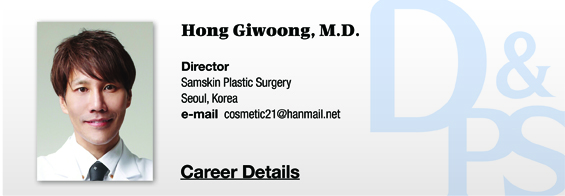
Manually Created Thread Cogs
The field of minimally invasive plastic surgery has recently become more diversified and technically developed. However, when it was first introduced in Korea about two decades ago, no one expected this field to blossom into today’s level. Up to the early and mid 1990s, dermal fillers consisted of only one type – the collagen filler developed in the US, which only lasted 1-2 months at most. And each case had to go through pre-treatment skin test to screen for allergic reactions. Few Korean doctors used this collagen filler in their practice due to these disadvantages. In the late 1990s, the European manufacturer of Q-med produced an HA filler named Restylane(currently produced by Galderma), which was quickly introduced in Korea and started being used in clinical practice. Volume enhancing dermal fillers were not yet available at the time and fillers were mainly used to smooth wrinkles or correct surface indentations. It was only in the last few years that fillers started being used in volume enhancement or face contouring.
Botulinum toxin, known as the trade name of Botox, is also referred to as a neuromodulator abroad and simply as “toxin” in Korea. In the late 1990s, when HA dermal filler was also introduced, Daewoong Pharmaceutical of Korea started importing Allergan’s Botox and introduced it to the Korean market. Today, one may think it commonplace to use an injection to smooth out an expression wrinkle. But at the time, the idea was sensational. Most doctors had no training on the usage and had to follow the manufacturer’s guidelines to perform the injection. In the early days, botulinum toxin was very costly and resulted in frequent complications of muscle paralysis. I appeared on a TV show to discuss about botulinum toxin after which I received many enquiries regarding the procedure. Even at that time, many people were interested in improving one’s facial wrinkles without surgery.
Thread lift is recently becoming quite popular. The Aptos thread, developed in Russia in the early 2000s, was the world’s first cogged thread. The cogs on the shaft of the thread adhere and pull on the skin to give a lifting effect. When Korean doctors first came across the Aptos thread, they were skeptical of the possibility of non-surgical face lift. As this thread was costly, a local manufacturer created an instrument that created cogs on a nylon thread manually and tried to sell it to many doctors. Many other types of lifting threads later entered the Korean market. Today, various Korean manufacturers are producing quality threads. The Aptos thread, which led the sensation, was not as effective as its high price and was gradually pushed out of the market. New and more effective threads were developed in a matter of a few years. Among these was a cogless mono-thread which became quite popular. Surgical techniques of thread lift also improved greatly, allowing for a greater range of indications. Also, thread lift has been combined with other minimally invasive procedures such as dermal & volume filer, botulinum toxin, laser, and RF, etc. for better results.
In my private practice, I do not perform laser, RF or ultrasound treatments frequently. However, I did train in laser treatments by irradiating it on porcine skin. The market for dermatologic laser has come a long way from the early days and now many Korean manufacturers are exporting their excellent devices around the world.
I was one of the very first plastic surgeons to perform minimally invasive plastic surgery in Korea. In this new series, I would like to review the history of minimally invasive plastic surgery(focusing on botulinum toxin, dermal & volume fillers, and thread lift) in Korea. I will also discuss how to define the treatment goals for more natural outcomes, consultation techniques, differences between Korean and Caucasian faces, treatment standards and methods for Korean patients, anatomical considerations for avoiding vascular and nerve damage, etc. Especially in the treatment of filler and toxin injection, I will include details of how to perform the procedures based on anatomical and technical considerations for each of the facial area.
[Advertisement] MAGNUM(Q-switched Nd:YAG Laser) – Manufacturer: (www.i-dana.com)]
As information about types, ingredients and characteristics of filler, thread and botulinum toxin products as well as basic treatment techniques and precautions can be easily obtained from books and manufacturer websites, etc., I will focus on my personal experience with performing minimally invasive procedures and techniques needed for special or difficult cases.
I hope my colleagues who are already specializing in or want to learn more about these procedures will benefit from my in-depth discussions on the relevant topics. Some may disagree with me but my motivation for writing this series is not to draw lines between correct and wrong but rather to add to the discussion of how to increase safety and efficacy of minimally invasive plastic surgery.
-To be continued




















